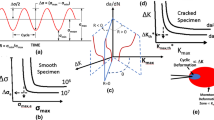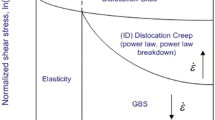Abstract
The interaction of creep and fatigue in structural materials under high-cycle loading is modeled using isochronic limit stress diagrams. The hypothesis of a unified limit diagram invariant to the time to failure is used. The unified diagram is given by a cosine power function with the exponent describing creep-fatigue interaction and encompasses convex, concave, and S-like curves. The models build are tested for aluminum alloys, heat-resistant steels, creep-resistant steels and alloys, and laminates
Similar content being viewed by others
REFERENCES
P. A. Antikain, Methods and Strength Analysis of Boilers and Pipelines [in Russian], Energiya, Moscow (1980).
L. N. Bol’shev and V. N. Smirnov, Tables of Mathematical Statistics [in Russian], Nauka, Moscow (1968).
V. P. Golub, V. I. Krizhanovskii, and A. D. Pogrebnyak, “A method for fatigue analysis of metallic and composite materials under asymmetric high-cycle loading,” Int. Appl. Mech., 40, No.11, 106–116 (2004).
J. Lemaitre and A. Plumtree, “Application of damage concepts to predict creep fatigue failure,” J. Eng. Mater. Technol., 101, 284–292 (1979).
Strength Calculation Standards for Equipment and Pipelines of Nuclear Power Plants (PNAE G-7-002-86), Energoatomizdat, Moscow (1989).
Yu. N. Rabotnov, Creep of Structural Members [in Russian], Nauka, Moscow (1966).
I. A. Birger and N. I. Koterov (eds.), Strength Analysis of Gas-Turbine Aero-Engines [in Russian], Mashinostroenie, Moscow (1984).
S. Taira and R. Ohtani, The Theory of High-Temperature Strength of Materials [Russian translation], Metallurgiya, Moscow (1986).
A. Hald, Statistical Theory with Engineering Applications, John Wiley & Sons, New York, Chapman & Hall, London (1946).
K. H. Boller, “Fatigue properties of fibrous glass-reinforced plastics laminates subjected to various conditions,” Modern Plastics, 34, 163–186, 293 (1957).
J. T. Boyle and J. Spence, Stress Analysis for Creep, Butterworths & Co., London (1983).
F. W. De Money, and B. J. Lazan, “Dynamic creep and rupture properties of an aluminum alloy under axial static and fatigue stress,” Proc. ASTM, 54, 769–785 (1954).
V. P. Golub, V. V. Kasperskaya, and A. A. Rusinov, “Time to creep failure of thin-walled cylindrical pipes under torsion,” Int. Appl. Mech., 40, No.6, 686–693 (2004).
V. P. Golub, “Experimental analysis of high-temperature creep, fatigue, and damage. 1. Analysis methods,” Int. Appl. Mech., 37, No.4, 425–455 (2001).
V. P. Golub, “Experimental analysis of high-temperature creep, fatigue, and damage. 2. Basic laws,” Int. Appl. Mech., 37, No.5, 565–601 (2001).
V. P. Golub, V. I. Krizhanovskii, and A. A. Rusinov, “A mixed criterion of delayed creep failure under plane stress,” Int. Appl. Mech., 39, No.5, 556–565 (2003).
R. B. Heywood, Designing Against Fatigue, Chapman and Hall, London (1962).
A. J. Kennedy, Processes of Creep and Fatigue in Metals, Oliver and Boyd, Edinburgh-London (1962).
Ya. A. Zhuk and I. K. Senchenkov, “Approximate model of thermomechanically coupled inelastic strain cycling,” Int. Appl. Mech., 36, No.3, 300–306 (2003).
Author information
Authors and Affiliations
Additional information
__________
Translated from Prikladnaya Mekhanika, Vol. 41, No. 1, pp. 25–36, January 2005.
Rights and permissions
About this article
Cite this article
Golub, V.P., Krizhanovskii, V.I., Pogrebnyak, A.D. et al. A Method of Modeling the Interaction of Creep and High-Cycle Fatigue. Int Appl Mech 41, 14–23 (2005). https://doi.org/10.1007/s10778-005-0053-0
Received:
Issue Date:
DOI: https://doi.org/10.1007/s10778-005-0053-0




